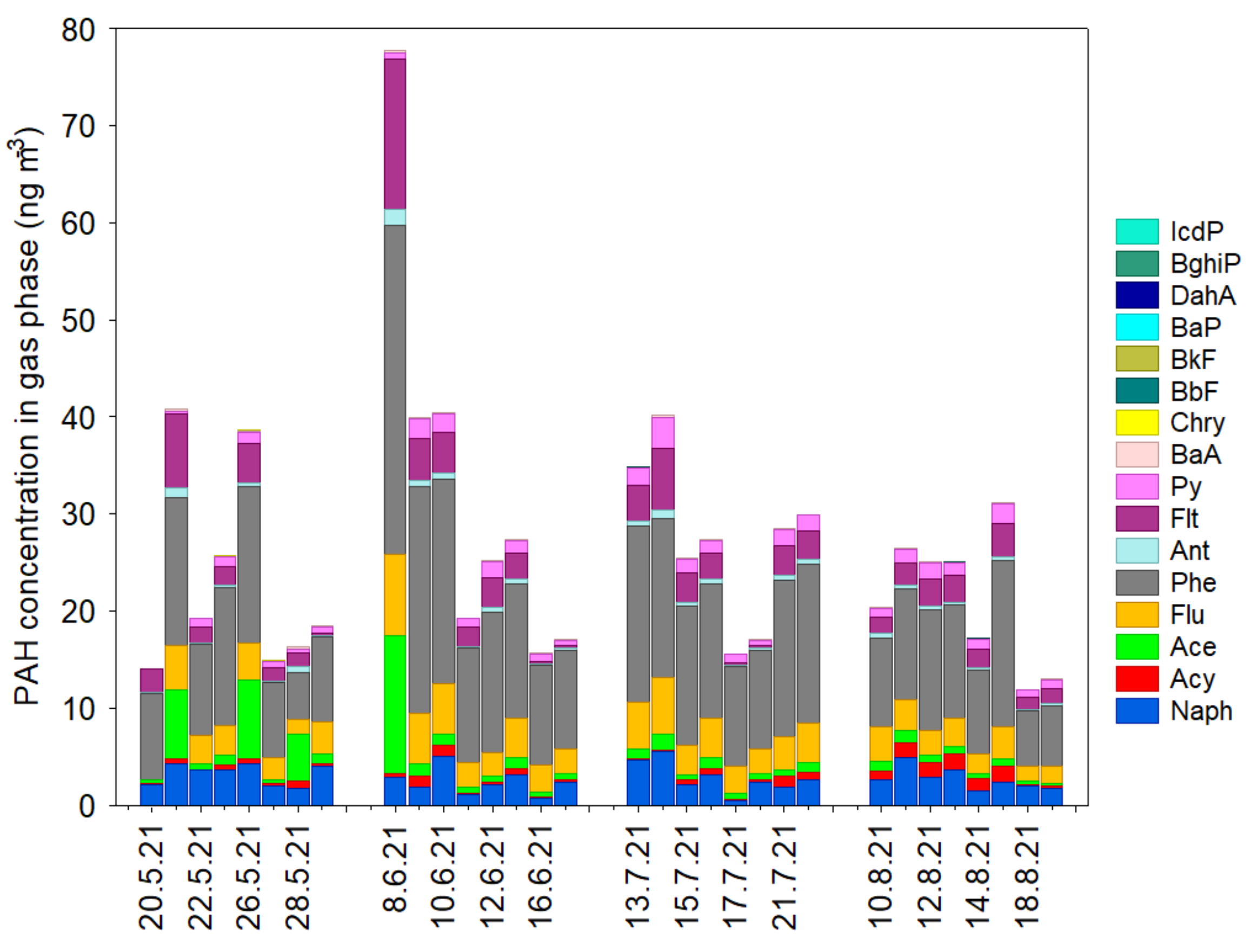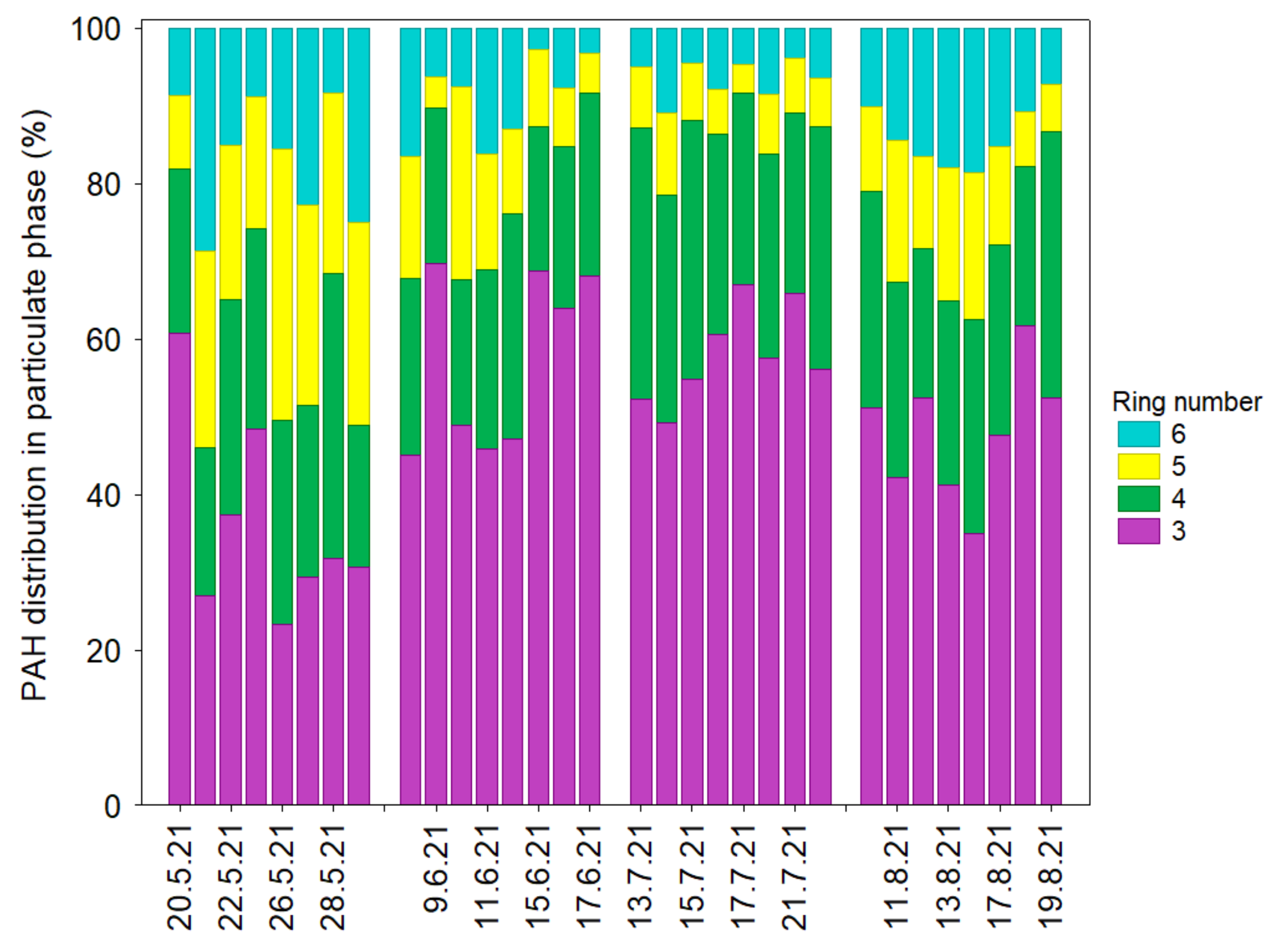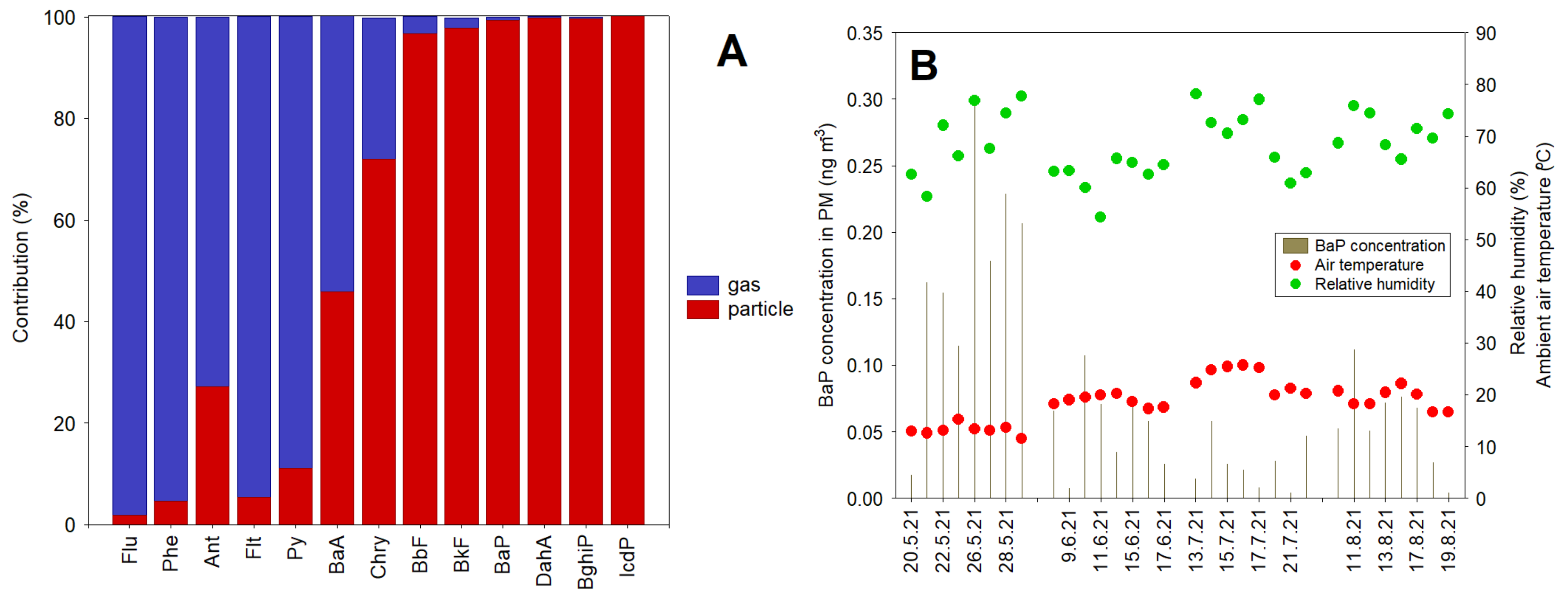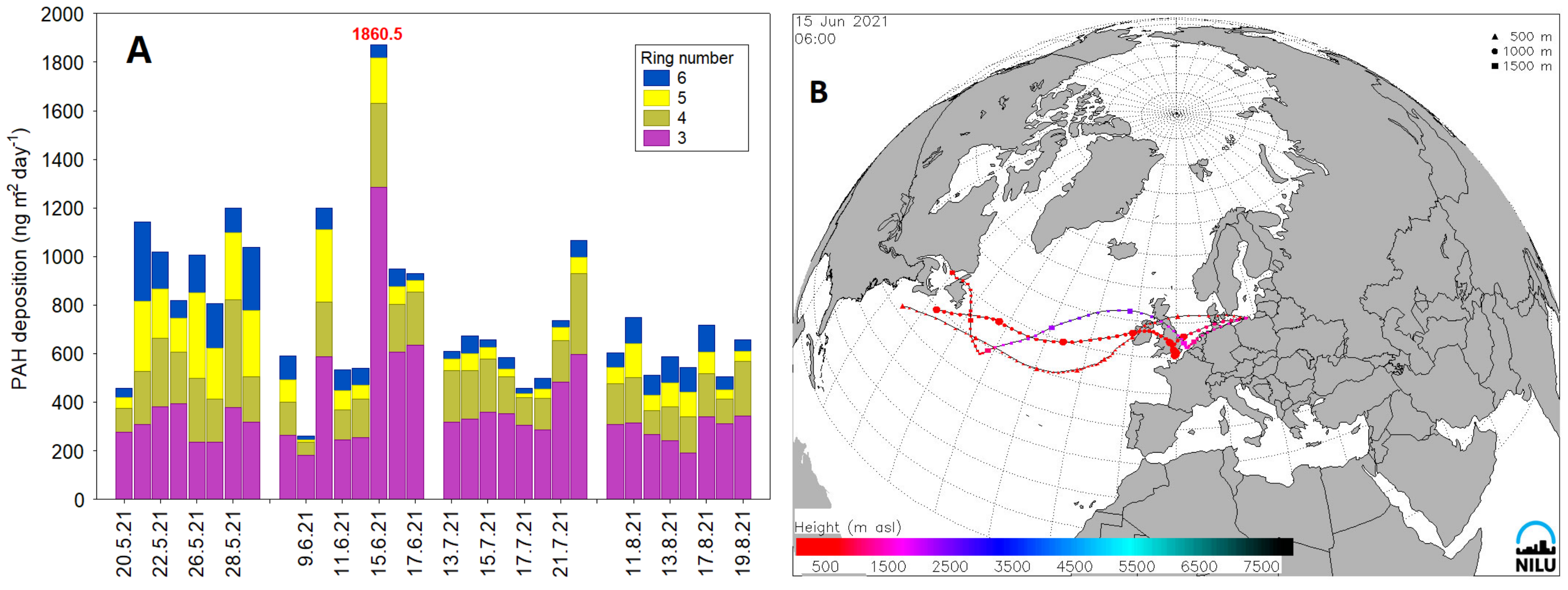Summertime Characteristics of Atmospheric Polycyclic Aromatic Hydrocarbons in a Coastal City of Northern Poland
Abstract
1. Introduction
2. Materials and Methods
2.1. Site Characteristic
2.2. Sample Collection and Isolation of PAHs
2.3. HPLC-FLD/DAD Analysis
2.4. Meteorological Data
2.5. PAHs Deposition Fluxes
3. Results and Discussion
3.1. Abundance and Composition of Gas and Particle PAH Compounds
3.2. Distribution of Particle PAH Compounds
3.3. Gas/Particle Partitioning
3.4. Summertime PAH Deposition Fluxes
4. Conclusions
Supplementary Materials
Funding
Institutional Review Board Statement
Informed Consent Statement
Data Availability Statement
Acknowledgments
Conflicts of Interest
References
- Keyte, I.J.; Harrison, R.M.; Lammel, G.M. Chemical reactivity and long-range transport potential of polycyclic aromatic hydrocarbons—A review. Chem. Soc. Rev. 2013, 42, 9333–9391. [Google Scholar] [CrossRef] [PubMed]
- Finlayson-Pitts, B.J.; Pitts, J.N. Chemistry of the Upper and Lower Atmosphere: Theory, Experiments, Applications; Academic Press: San Diego, CA, USA, 2000. [Google Scholar]
- Hayakawa, K. Environmental behaviors and toxicities of polycyclic aromatic hydrocarbons and nitropolycyclic aromatic hydrocarbons. Chem. Pharm. Bull. 2016, 64, 83–94. [Google Scholar] [CrossRef] [PubMed]
- Ray, D.; Ghosh, A.; Chatterjee, A.; Ghosh, S.K.; Raha, S. Size-specific PAHs and Associated Health Risks over a Tropical Urban Metropolis: Role of Long-range Transport and Meteorology. Aerosol Air Qual. Res. 2019, 19, 2446–2463. [Google Scholar] [CrossRef]
- Kongpran, J.; Kliengchuay, W.; Niampradit, S.; Sahanavin, N.; Siriratruengsuk, W.; Tantrakarnapa, K. The health risks of airborne polycyclic aromatic hydrocarbons (PAHs): Upper north Thailand. GeoHealth 2021, 5, e2020GH000352. [Google Scholar] [CrossRef] [PubMed]
- Kim, K.-H.; Jahan, S.A.; Kabir, E.; Brown, R.J.C. A review of airborne polycyclic aromatic hydrocarbons (PAHs) and their human health effects. Environ. Int. 2013, 60, 71–80. [Google Scholar] [CrossRef] [PubMed]
- Shamsedini, N.; Dehghani, M.; Samaei, M.; Azhdarpoor, A.; Hoseini, M.; Fararouei, M.; Bahrany, S.; Roosta, S. Health risk assessment of polycyclic aromatic hydrocarbons in individuals living near restaurants: A cross-sectional study in Shiraz, Iran. Sci. Rep. 2022, 12, 8254. [Google Scholar] [CrossRef]
- Hafner, W.D.; Carlson, D.L.; Hites, R.A. Influence of local human population on atmospheric polycyclic aromatic hydrocarbon concentrations. Environ. Sci. Technol. 2005, 39, 7374–7379. [Google Scholar] [CrossRef]
- Morville, S.; Delhomme, O.; Millet, M. Seasonal and diurnal variations of atmospheric PAH concentrations between rural, suburban and urban areas. Atmos. Pollut. Res. 2011, 2, 366–373. [Google Scholar] [CrossRef]
- Rogula-Kozłowska, W.; Kozielska, B.; Klejnowski, K. Concentration, origin and health hazard from fine particle-bound PAH at three characteristic sites in Southern Poland. Bull. Environ. Contam. Toxicol. 2013, 91, 349–355. [Google Scholar] [CrossRef]
- Pokorná, P.; Hovorka, J.; Klán, M.; Hopke, P.K. Source apportionment of size resolved particulate matter at a European air pollution hot spot. Sci. Total Environ. 2015, 502, 172–183. [Google Scholar] [CrossRef]
- Luo, M.; Ji, Y.; Ren, Y.; Gao, F.; Zhang, H.; Zhang, L.; Yu, Y.; Li, H. Characteristics and Health Risk Assessment of PM2.5-Bound PAHs during Heavy Air Pollution Episodes in Winter in Urban Area of Beijing, China. Atmosphere 2021, 12, 323. [Google Scholar] [CrossRef]
- Sun, J.; Shen, Z.; Zhang, T.; Kong, S.; Zhang, H.; Zhang, Q.; Niu, X.; Huang, S.; Xu, H.; Ho, K.-F.; et al. A comprehensive evaluation of PM2.5-bound PAHs and their derivative in winter from six megacities in China: Insight the source-dependent health risk and secondary reactions. Environ. Int. 2022, 165, 107344. [Google Scholar] [CrossRef] [PubMed]
- Liu, D.; Gao, S.; An, X. Distribution and source apportionment of Polycyclic aromatic hydrocarbons from atmospheric particulate matter PM2.5 in Beijing. Adv. Atmos. Sci. 2008, 25, 297–305. [Google Scholar] [CrossRef]
- Yang, Y.Y.; Guo, P.R.; Zhang, Q.; Li, D.L.; Zhao, L.; Mu, D.H. Seasonal variation, sources and gas/particle partitioning of polycyclic aromatic hydrocarbons in Guangzhou, China. Sci. Total Environ. 2010, 408, 2492–2500. [Google Scholar] [CrossRef] [PubMed]
- Chimjarn, S.; Delhomme, O.; Millet, M. Temporal Distribution and Gas/Particle Partitioning of Polycyclic Aromatic Hydrocarbons (PAHs) in the Atmosphere of Strasbourg, France. Atmosphere 2021, 12, 337. [Google Scholar] [CrossRef]
- Ringuet, J.; Albinet, A.; Leoz-Garziandia, E.; Budzinski, H.; Villenave, E. Reactivity of polycyclic aromatic compounds (PAHs, NPAHs and OPAHs) adsorbed on natural aerosol particles exposed to atmospheric oxidants. Atmos. Environ. 2012, 61, 15–22. [Google Scholar] [CrossRef]
- Lammel, G.; Audy, O.; Besis, A.; Efstathiou, C.; Eleftheriadis, K.; Kohoutek, J.; Kukučka, P.; Mulder, M.D.; Přibylová, P.; Prokeš, R.; et al. Air and seawater pollution and air-sea gas exchange of persistent toxic substances in the Aegean Sea: Spatial trends of PAHs, PCBs, OCPs and PBDEs. Environ. Sci. Pollut. Res. Int. 2015, 22, 11301–11313. [Google Scholar] [CrossRef] [PubMed]
- Elzein, A.; Stewart, G.J.; Swift, S.J.; Nelson, B.S.; Crilley, L.R.; Alam, M.S.; Reyes-Villegas, E.; Gadi, R.; Harrison, R.M.; Hamilton, J.F.; et al. A comparison of PM2.5-bound polycyclic aromatic hydrocarbons in summer Beijing (China) and Delhi (India). Atmos. Chem. Phys. 2020, 20, 14303–14319. [Google Scholar] [CrossRef]
- Lewandowska, A.U.; Staniszewska, M.; Witkowska, A.; Machuta, M.; Falkowska, L. Benzo(a)pyrene parallel measurements in PM1 and PM2.5 in the coastal zone of the Gulf of Gdansk (Baltic Sea) in the heating and non-heating seasons. Environ. Sci. Pollut. Res. 2018, 25, 19458–19469. [Google Scholar] [CrossRef]
- Siudek, P.; Frankowski, M. The Role of Sources and Atmospheric Conditions in the Seasonal Variability of Particulate Phase PAHs at the Urban Site in Central Poland. Aerosol Air Qual. Res. 2018, 18, 1405–1418. [Google Scholar] [CrossRef]
- Siudek, P. Compositional and seasonal differences of gas and particle phase polycyclic aromatic hydrocarbons (PAHs) over the southern Baltic Sea coast. Sci. Rep. 2022, 12, 21005. [Google Scholar] [CrossRef] [PubMed]
- Siudek, P. Seasonal distribution of PM2.5-bound polycyclic aromatic hydrocarbons as a critical indicator of air quality and health impact in a coastal urban region of Poland. Sci. Total Environ. 2022, 827, 154375. [Google Scholar] [CrossRef] [PubMed]
- Zhang, L.; Cheng, I.; Wu, Z.; Harner, T.; Schuster, J.; Charland, J.P.; Muir, D.; Parnis, J.M. Dry deposition of polycyclic aromatic compounds to various land covers in the Athabasca oil sands region. J. Adv. Model. Earth Syst. 2015, 7, 1339–1350. [Google Scholar] [CrossRef]
- Teixeira, E.C.; Porta Mattiuzi, C.D.; Agudelo-Castañeda, D.M.; de Oliveira Garcia, K.; Wiegand, F. Polycyclic aromatic hydrocarbons study in atmospheric fine and coarse particles using diagnostic ratios and receptor models in urban/industrial regions. Environ. Monit. Assess. 2013, 185, 9587–9602. [Google Scholar] [CrossRef]
- Jakovljević, I.; Štrukil, Z.S.; Godec, R.; Bešlić, I.; Davila, S.; Lovrić, M.; Pehnec, G. Pollution Sources and Carcinogenic Risk of PAHs in PM1 Particle Fraction in an Urban Area. Int. J. Environ. Res. Public Health 2020, 17, 9587. [Google Scholar] [CrossRef]
- Castro-Jiménez, J.; Berrojalbiz, N.; Wollgast, J.; Dachs, J. Polycyclic aromatic hydrocarbons (PAHs) in the Mediterranean Sea: Atmospheric occurrence, deposition and decoupling with settling fluxes in the water column. Environ. Pollut. 2012, 166, 40–47. [Google Scholar] [CrossRef]
- Fernandez, P.; Grimalt, J.O.; Vilanova, R.M. Atmospheric gas-particle partitioning of polycyclic aromatic hydrocarbons in high mountain regions of Europe. Environ. Sci. Technol. 2022, 36, 1162–1168. [Google Scholar] [CrossRef]
- Pratt, G.C.; Herbrandson, C.; Krause, M.J.; Schmitt, C.; Lippert, C.J.; McMahon, C.R.; Ellickson, K.M. Measurements of gas and particle polycyclic aromatic hydrocarbons (PAHs) in air at urban, rural and near-roadway sites. Atmos. Environ. 2018, 179, 268–278. [Google Scholar] [CrossRef]
- Prats, R.M.; van Drooge, B.L.; Fernández, P.; Marco, E.; Grimalt, J.O. Changes in Urban Gas-Phase Persistent Organic Pollutants During the COVID-19 Lockdown in Barcelona. Front. Environ. Sci. 2021, 9, 650539. [Google Scholar] [CrossRef]
- Kuzu, S.L. Compositional variation of PCBs, PAHs, and OCPs at Gas phase and size segregated particle phase during dust incursion from the Saharan desert in the Northwestern Anatolian peninsula. Adv. Meteorol. 2016, 2016, 7153286. [Google Scholar] [CrossRef]
- Wang, T.; Zhao, J.; Liu, Y.; Peng, J.; Wu, L.; Mao, H. PM2.5-bound polycyclic aromatic hydrocarbons (PAHs), nitrated PAHs (NPAHs), and oxygenated PAHs (OPAHs) in typical traffic-related receptor environments. J. Geophys. Res. Atmos. 2022, 127, e2021JD035951. [Google Scholar]
- Soggiu, M.E.; Inglessis, M.; Gagliardi, R.V.; Settimo, G.; Marsili, G.; Notardonato, I.; Avino, P. PM10 and PM2.5 qualitative source apportionment using selective wind direction sampling in a port-industrial area in Civitavecchia. Italy. Atmosphere 2020, 11, 94. [Google Scholar] [CrossRef]
- Terzi, E.; Samara, C. Gas-Particle Partitioning of Polycyclic Aromatic Hydrocarbons in Urban, Adjacent Coastal, and Continental Background Sites of Western Greece. Environ. Sci. Technol. 2004, 38, 4973–4978. [Google Scholar] [CrossRef] [PubMed]
- Mu, Q.; Shiraiwa, M.; Octaviani, M.; Ma, N.; Ding, A.; Su, H.; Lammel, G.; Pöschl, U.; Cheng, Y. Temperature effect on phase state and reactivity controls atmospheric multiphase chemistry and transport of PAHs. Sci. Adv. 2018, 4, eaap7314. [Google Scholar] [CrossRef] [PubMed]
- Kim, J.Y.; Lee, J.Y.; Choi, S.-D.; Kim, Y.P.; Ghim, Y.S. Gaseous and particulate polycyclic aromatic hydrocarbons at the Gosan background site in East Asia. Atmos. Environ. 2012, 49, 311–319. [Google Scholar] [CrossRef]





| Site | Type | Elevation | Description | Wind Sector |
|---|---|---|---|---|
| Gdynia (Poland) | Coastal urban | 20 m height a.g.l. | Surrounded by maritime ports and docks, ship repair yards. | W-NW, SE |
| Shipping emissions: (Baltic Sea), Bay of Puck. | (N), NE-E-SE | |||
| Near buildings, i.e., commercial/residential, domestic heating units, coal-fired heating boilers. | S-SW-W-NW | |||
| Relatively high traffic density. | S-SW-W-NW | |||
| Major industrial sources such as petrochemical refineries, steel manufacturing, coal-fired power plants and municipal solid waste recycling units are about 10–20 km from the sampling site. | SE-S-SW-W-NW |
| Compound | Gas Phase | Particle Phase | ||||
|---|---|---|---|---|---|---|
| Mean ± 1 S.D. (n = 32) | Min | Max | Mean ± 1 S.D. (n = 32) | Min | Max | |
| Naph | 2.78 ± 1.27 | 0.52 | 5.50 | - | - | - |
| Acy | 0.62 ± 0.52 | 0.04 | 1.70 | - | - | - |
| Ace | 1.76 ± 2.91 | 0.25 | 14.22 | - | - | - |
| Flu | 3.33 ± 1.54 | <d.l. | 8.45 | 0.06 ± 0.06 | 0.02 | 0.39 |
| Phe | 13.18 ± 5.74 | 4.83 | 33.92 | 0.65 ± 0.37 | 0.30 | 2.39 |
| Ant | 0.42 ± 0.30 | 0.09 | 1.64 | 0.16 ± 0.12 | 0.01 | 0.43 |
| Flt | 2.89 ± 2.83 | 0.18 | 15.42 | 0.16 ± 0.07 | 0.05 | 0.37 |
| Pyr | 1.17 ± 0.64 | 0.02 | 3.24 | 0.15 ± 0.07 | 0.04 | 0.33 |
| BaA | 0.09 ± 0.07 | <d.l. | 0.27 | 0.08 ± 0.10 | 0.01 | 0.33 |
| Chry | 0.02 ± 0.01 | <d.l. | 0.05 | 0.06 ± 0.03 | 0.01 | 0.15 |
| BbF | - | - | - | 0.09 ± 0.08 | 0.01 | 0.31 |
| BkF | - | - | - | 0.05 ± 0.04 | <d.l. | 0.17 |
| BaP | - | - | - | 0.08 ± 0.07 | <d.l. | 0.30 |
| DahA | - | - | - | 0.05 ± 0.08 | <d.l. | 0.37 |
| BghiP | - | - | - | 0.11 ± 0.08 | 0.03 | 0.36 |
| IcdP | - | - | - | 0.09 ± 0.09 | <d.l. | 0.42 |
| Total | 26.26 ± 15.83 | 5.93 | 84.42 | 1.77 ± 1.26 | 0.49 | 6.33 |
Disclaimer/Publisher’s Note: The statements, opinions and data contained in all publications are solely those of the individual author(s) and contributor(s) and not of MDPI and/or the editor(s). MDPI and/or the editor(s) disclaim responsibility for any injury to people or property resulting from any ideas, methods, instructions or products referred to in the content. |
© 2023 by the author. Licensee MDPI, Basel, Switzerland. This article is an open access article distributed under the terms and conditions of the Creative Commons Attribution (CC BY) license (https://creativecommons.org/licenses/by/4.0/).
Share and Cite
Siudek, P. Summertime Characteristics of Atmospheric Polycyclic Aromatic Hydrocarbons in a Coastal City of Northern Poland. Int. J. Environ. Res. Public Health 2023, 20, 4475. https://doi.org/10.3390/ijerph20054475
Siudek P. Summertime Characteristics of Atmospheric Polycyclic Aromatic Hydrocarbons in a Coastal City of Northern Poland. International Journal of Environmental Research and Public Health. 2023; 20(5):4475. https://doi.org/10.3390/ijerph20054475
Chicago/Turabian StyleSiudek, Patrycja. 2023. "Summertime Characteristics of Atmospheric Polycyclic Aromatic Hydrocarbons in a Coastal City of Northern Poland" International Journal of Environmental Research and Public Health 20, no. 5: 4475. https://doi.org/10.3390/ijerph20054475
APA StyleSiudek, P. (2023). Summertime Characteristics of Atmospheric Polycyclic Aromatic Hydrocarbons in a Coastal City of Northern Poland. International Journal of Environmental Research and Public Health, 20(5), 4475. https://doi.org/10.3390/ijerph20054475






